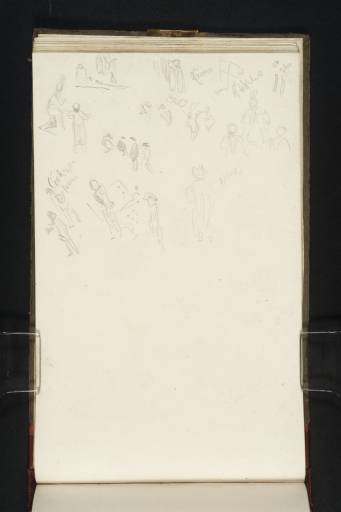Joseph Mallord William Turner Figures: Laying of the Foundation Stone of the National Monument, Calton Hill 1822
Image 1 of 2
Joseph Mallord William Turner,
Figures: Laying of the Foundation Stone of the National Monument, Calton Hill
1822
Joseph Mallord William Turner 1775–1851
Folio 26 Verso:
Figures: Laying of the Foundation Stone of the National Monument, Calton Hill 1822
D17548
Turner Bequest CC 26a
Turner Bequest CC 26a
Pencil on white wove paper, 187 x 114 mm
Inscribed in pencil by Turner ‘[...] | [?]Highland’ top, ‘Blue’ top right, ‘Blue’ across figure beneath other inscriptions, ‘Blue’ next to bottom right figure, ?‘Cockerell’ | f[...]’ left, ‘Red’ to the left of bottom left figure
Blindstamped with the Turner Bequest stamp upper centre right
Inscribed in pencil by Turner ‘[...] | [?]Highland’ top, ‘Blue’ top right, ‘Blue’ across figure beneath other inscriptions, ‘Blue’ next to bottom right figure, ?‘Cockerell’ | f[...]’ left, ‘Red’ to the left of bottom left figure
Blindstamped with the Turner Bequest stamp upper centre right
Accepted by the nation as part of the Turner Bequest 1856
References
1909
A.J. Finberg, A Complete Inventory of the Drawings of the Turner Bequest, London 1909, vol.I, p.611, CC 26a, as ‘Figures seen from above.’.
1981
Gerald Finley, Turner and George the Fourth in Edinburgh 1822, exhibition catalogue, Tate Gallery, London 1981, pp.20, 82, [118] reproduced as ‘Ceremony of the laying of the foundation stone of the National Monument’.
With the sketchbook turned to the right are a series of sketches of people involved in the ceremony of the laying of the foundation stone of the National Monument (see folio 22 verso; D17540). While Turner has depicted the figures in more detail than in some of his other sketches of the occasion (for example folio 22 verso), paying attention to their costumes and poses, the studies are still rather obscure and hard to decipher without reference to accounts of the event.1
While the other sketches of the sequence tend to capture a single moment within a sequence of events which unfold across the sketches, this page has been used for a mixture of sketches of the activities of various participants at different points in the ceremony, of individuals at the ceremony and of details of particular objects of interest.
At the top left is a sketch showing several figures, one of which may be on his knees at the edge of the foundations. Although there is not enough detail to be very certain it is possible that this tiny sketch depicts one of the Masonic rites described by Mudie:
The senior Grand Warden then applied the square, the Junior Warden the plumb-line, and the Substitute Grand Master the level; and having gone through the other usual solemnities, the Grand Master gave the stone three knocks with a mallet, and craved the following benediction on the work2
Beneath this is another sketch of two figures which appears to depict a specific moment of significance. The figure at the left, who wears a gown and elaborate headgear appears to bow on one knee, while the other – his back to us – holds out his arms; a gesture that may have been made by the Reverend Dr Lee, the Grand Chaplain of the Masonic Lodge, when he gave his prayer at the ceremony.3 Two sketches at the centre of the cluster of drawings both show four stooped figures; perhaps helping to lay the foundation stone.
At the bottom centre are two figures with a series of dots between them. The dots may be an idiosyncratic shorthand technique of Turner’s (as in folio 22 verso) in which case their meaning remains obscure. However, there is a chance that they could represent grains of corn, scattered on the foundation stone by the Grand Master as part of a Masonic ceremony (see folio 23 verso; D17542 for more information).
Although the two figures at the bottom left are not particularly distinctive the inscription next to them may refer to Charles Robert ‘Cockerell’, the English architect who was among the officials at the laying of the foundation stone and whom Turner knew personally and spent time with in Edinburgh in 1822.4 The other figure wears a ‘red’ hat or scarf. At the bottom right is a figure in a flowing ‘blue’ gown and what looks like a crown, though it could be a bonnet, with his back to us. Whoever he was Turner evidently regarded him as important enough to depict here. Three figures at the right, again with their backs to us, wearing ‘blue’ jackets, shoulder straps and bonnets, one with feathers in it, are probably members of the band as seen on folio 25 verso, and perhaps on folio 27 verso (D17546, D17550).
There is also, at the top right of the page, a sketch of two flags and two double lines that may represent shoulder straps. Both probably belong to the band as the same features appear on 27 verso. The inscriptions at this part of the sketch are indecipherable apart from the word ‘Highland’, which refers to some of the clansmen present at the event. Although Turner included the foundation stone ceremony in the ‘Royal Progress’ proposal (see King at Edinburgh sketchbook Tate D40979; Turner Bequest CCI 43a), he did not develop the subject itself any further; he did however make a tiny watercolour called The March of the Highlanders for Fishers Illustrations to the Waverley Novels of Sir Walter Scott, circa 1836 (Tate N04953), which was based on the procession towards the ceremony.
Thomas Ardill
October 2008
How to cite
Thomas Ardill, ‘Figures: Laying of the Foundation Stone of the National Monument, Calton Hill 1822 by Joseph Mallord William Turner’, catalogue entry, October 2008, in David Blayney Brown (ed.), J.M.W. Turner: Sketchbooks, Drawings and Watercolours, Tate Research Publication, December 2012, https://www


